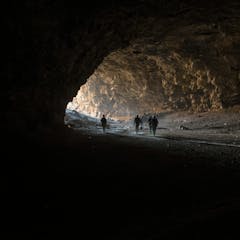
Articles on Caves
Displaying 1 - 20 of 32 articles

Finding and retrieving the bones of this extinct kangaroo relative – a ‘holy grail’ fossil – took hours of squeezing through narrow passages.

New research reveals signs of ancient human habitation in a vast cave beneath the Arabian desert. It may have been used as a waystation by Stone Age herders travelling from one oasis to another.

Despite cold temperatures, water was relatively abundant in much of the southern hemisphere during ice ages.

What happened to the three-metre tall apes that once lived alongside orangutans? A new study suggests they were too slow to adapt to a changing world.

Most of us see only the dry treeless plain and spectacular sea cliffs. But beneath the surface there’s a precious world of caves and unique species that could be lost without better protection.

South-west Australia relies on groundwater for three-quarters of its water use. But a new study of the region’s caves has found a drying climate is having a dramatic impact on this precious resource.

One person recently spent 100 days underwater. Another lived 500 days in a cave. What can we learn from such extreme experiences?

Beatriz Flamini may have set a new record for longest voluntary isolation.

The caves now serve as important safe spaces in an area designated ‘Firing Zone 918’ by Israel, as residents describe a growing wave of forced evictions and building demolitions.

The findings will help us better understand how biodiversity responds to a changing climate over time.

As water dripped in a remote cave, it left behind evidence of every monsoon season for a millennium. Scientists say it holds a warning for a country about to become the most populous on Earth.

Caves form over millions of years, as a result of flowing water slowly working away at ‘soft’ calcareous rock.

Cave-specific conservation and protection actions are essential to protect cave habitats for the continued survival of bats, and ultimately, the well-being of humans.

For thousands of years, Native Americans left their artistic mark deep within caves in the American Southeast. It wasn’t until 1980 that these ancient visual expressions were known to archaeologists.

Laboratory experiments with bat poo reveal how archaeological materials in tropical caves have been chemically altered over the millennia.

Early humans called Denisovans lived in a remote mountain cave between 100,000 and 60,000 years ago, and possibly longer still, raising intriguing questions about their relationship to modern humans.

Ancient poo from bats and birds can tell you what type of vegetation they were feeding on at that time.

A new discovery adds to our existing understanding of Homo sapiens in Africa.

And here’s what to do once a future sinkhole has been identified.

There are at least 400,000 stateless people living in Thailand – many of them young, like Adul. Here’s what their lives are like.
